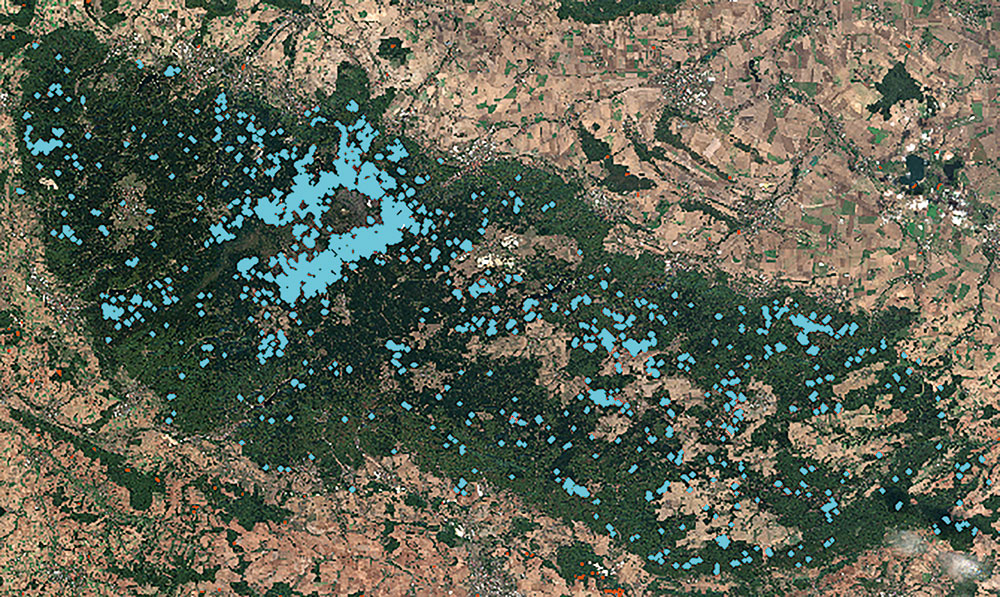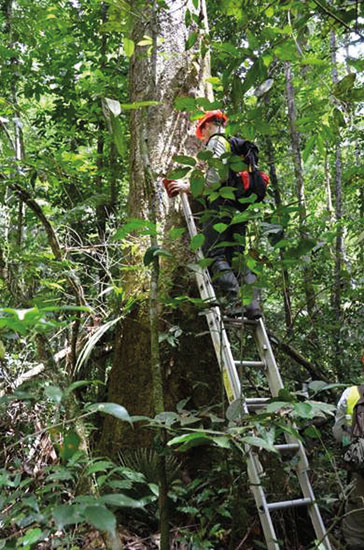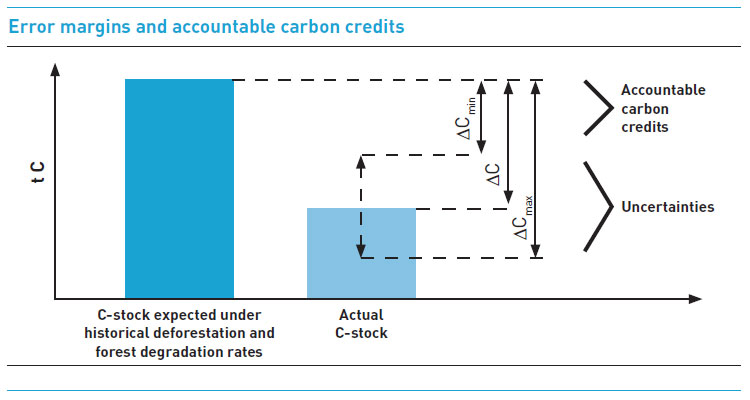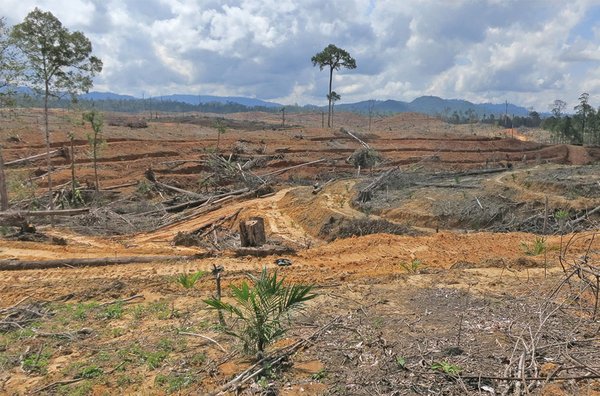 Download this article in magazine layout
Download this article in magazine layout
- Share this article
- Subscribe to our newsletter
Rainforest protection with contrary effects – high transaction costs can jeopardise the successful implementation of REDD+
The continuing deforestation and degradation of tropical forests and the associated negative consequences such as loss of biodiversity and CO2 emissions have motivated the international community to consider the conservation of forests as a climate protection measure. At their 13th Conference of Parties (COP 13) in 2007, the member states of the United Nations Framework Convention on Climate Change (UNFCCC) agreed on REDD+ (Reducing Emissions from Deforestation and Forest Degradation) as a national strategy for developing countries to reduce their greenhouse gas (GHG) emissions. The basic idea of REDD+ is to create economic benefits for forest conservation through incentive payments and the remuneration of emission reductions (carbon financing). The REDD+ process is currently entering a new era as many countries are about to finish their REDD+ readiness phase and are now negotiating Emission Reductions Payment Agreements (ERPA). ERPAs are documents in which the seller (i.e. a REDD+ country) and the buyer (i.e. the Forest Carbon Partnership Facility Carbon Fund) agree on the commercial terms of the sale and payment of Emission Reductions (ERs). Since deforestation is a large contributor to the global GHG emissions (Federici et al., 2015), emission reductions as set by the goals of the Paris Agreement (PA) can only be achieved by halting global forest loss. In Article 5.2 of the PA, the reduction of emissions from deforestation and forest degradation in developing countries is stated as a measure to reduce global GHG emissions and is directly linked to results-based payments (UNFCCC, 2015).
When implementing a national REDD+ scheme, countries follow a phased approach: capacity building or readiness in Phase 1, followed by the successful implementation of policy reforms in Phase 2 until compensation payments of results, that is actual emissions reductions and increase in forest carbon stocks in Phase 3 (Angelsen, 2017). The results-based payments are financed by public funding, of which more than 80 per cent is contributed by Australia, Germany, Norway, the United Kingdom and the USA. About one third of the public funding is distributed through the World Bank, the Global Environmental Facility, the Green Climate Fund and the UN-REDD Programme (Norman and Nakhooda, 2014). The funds are used to cover direct costs for REDD+ activities as well as transaction costs for information, enforcement, implementation and monitoring. The transaction costs are the decisive factor in determining the proportion of payments remaining as incentives. In order to maintain REDD+ as a cost-efficient climate mitigation action, the transaction costs must be kept low.

Activity data : Sentinel 2 remote sensing data, with blue patches showing deforestation areas (provided by courtesy of GAF, Munich).
Emission factors (right): tree measurements in Suriname (UHH/CEN/Michael Köhl).
This is where our current study sets in, examining the implementation costs of national REDD+ programmes in more detail (Köhl et al., 2020). In order to demonstrate national emission reductions through REDD+ activities, countries need to have a measurement reporting and verification (MRV) system in place. The MRV system provides information on forest C-stocks and is a mandatory prerequisite for the comparison of national forest C-stock changes after implementing REDD+ activities with those which would be expected if deforestation and forest degradation activities of past years were to be continued unchanged. MRV systems use two fundamentally different data sources: (1) activity data, which refer to area change data and include deforestation, degradation and afforestation activities (see upper photo), and (2) emission factors, which quantify GHG emissions and removals per unit area (see lower photo). Activity data (AD) are provided by remote sensing sensors, while emission factors (EF) are usually obtained by sample based in-situ forest assessments (see Photos above). Costs are incurred for the collection, evaluation and verification of the relevant AD and EF, which often account for a significant proportion of transaction costs.
What sounds rather straightforward so far is much more complicated in practical implementations. The Intergovernmental Panel on Climate Change (IPCC) and the Forest Carbon Partnership Facility (FCPF) have drawn up guidelines to be applied when implementing MRV systems (IPCC, 2006; FCPF, 2016; IPCC, 2019) in order to guarantee estimates that are transparent, consistent over time and accurate. An essential part of these guidelines relates to the verification of C-stock changes and the resulting CO2 removals and emissions. Recording changes in land use using satellite data as well as determining the changes of forest C-stocks is prone to errors. These errors must be taken into account when estimating CO2 emissions and removals, and can be considerable. For example, for Fiji, which has a forest area of around 9,000 km2, a margin of error has been estimated ranging from 850,000 to 2.3 million tons of CO2 emissions. It is not possible to specify which value actually applies within this interval. In order to avoid unjustified incentive payments, the value of the error interval that leads to the lowest CO2 credits must always be used (see Figure).
For countries that want to introduce REDD+, this poses an optimisation problem. To what extent should the error be reduced in order to obtain the highest possible incentive payment? Reducing the estimation errors renders investments in the application of better but also more expensive assessment methods necessary, which must be balanced against the increased incentive payments.

In our study, we show that especially for countries with historically low deforestation and forest degradation rates, the achievable incentive payments can be very low or even insufficient to cover the collection costs. With the carbon price currently paid by the FCPF at five US dollars per tonne of CO2, additional financing is needed to successfully implement REDD+. The envisaged market mechanism for REDD+ will therefore not become operational. We recommend that the optimisation of the MRV design meet accuracy and cost requirements. The optimisation criterion for MRV systems should not be the highest possible accuracy, but the highest possible carbon credits. This contradicts the requirements for the greatest possible accuracy, as stipulated in the International Panel on Climate Change’s (IPCC) and Forest Carbon Partnership Facility’s (FCPF) recommendations for action.
Michael Köhl is a professor and Philip Mundhenk and Prem Rai Neupane are Research Associates at the Center for Earth System Research and Sustainability, Institute of Wood Science – World Forestry, at the University of Hamburg, Germany.
References and further reading
Angelsen, A., 2017. REDD+ as result-based aid: General lessons and bilateral agreements of Norway. Review of Development Economics 21, 237-264.
FCPF, 2016. Carbon fund methodological framework.
Federici, S., Tubiello, F.N., Salvatore, M., Jacobs, H., Schmidhuber, J., 2015. New estimates of CO2 forest emissions and removals: 1990–2015. Forest Ecology and Management 352, 89-98.
IPCC, 2006. IPCC Guidelines for national greenhouse gas inventories: energy. In: Eggleston, H.S., Buendia, L., Miwa, K., Ngara, T., Tanabe, K. (Eds.), 2006 IPCC Guidelines for National Greenhouse Gas Inventories. National Greenhouse Gas Inventories Programme, Hayama, Japan.
IPCC, 2019. 2019 Refinement to the 2006 IPCC Guidelines for National Greenhouse Gas Inventories.
Köhl, M., Neupane, P.R., Mundhenk, P., 2020. REDD+ measurement, reporting and verification – A cost trap? Implications for financing REDD+MRV costs by result-based payments. Ecological Economics 168, 106513.
Norman, M., Nakhooda, S., 2014. The state of REDD+ finance. Center for Global Development, Washington DC.
UNFCCC, 2015. Paris Agreement.




